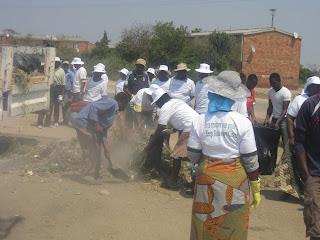Five more alternative technologies have been introduced in Dabane trust's programmes. These have been devised in a in order to cater for those areas that cannot accommodate the well point technology. The alternative technologies include:
- Caissons
- Sand dams
- Tube wells
- Bio-sand filters
- Underground tanks
Caissons
Caissons as typically larger structures than well-points or infiltration galleries which are installed directly into the riverbed or into alluvial riverbanks where there is low permeability. Lower sections of the caissons are permeable so that water flows from the sediment into the caisson and eventually creates a graded filter around the base of the caisson.
A caisson can be considered to be a well shaft that does not reach the surface. It is generally covered by a slab with a narrow diameter connection either vertically to the surface or horizontally to a sump on the riverbank. Conditions necessary for Caisson Construction include fine aeolian sands, low permeability and low porosity.
Sand dams
The type of riverbeds that are most convenient for sand dam construction have hilly and stony catchments that produce coarse sand where up to 350litres of water can be extracted from 1litre cubic metres of sand. Such rivers are suitable for sand abstraction projects. The main purpose of sand dam is to increase the volume of sand and water in riverbeds by putting a barrier (dam wall) on a river channel.
Listed below are the conditions that are suitable for sand dam projects:
- Two high riverbanks to enable the wing walls to keep over-flowing flood water within the spillway and not flowing over the riverbanks
- Dam walls should never be built on fractured rocks or large boulders because such walls cannot be made water tight. Water will always seep out between the boulders.
- Riverbeds with fine textured sand originating from flat land are also unsuitable for sand dams because less than 5% of the stored in the voids between the sand particles can be extracted.
- Water- indicating vegetation, that requires water all year round, should be growing on the banks where the reservoir will be located as proof of the riverbed capacity to store water.
Bio- sand filter tank
This can be defined as an innovation on traditional slow sand water filters, specifically designed for intermittent or household use. The filter container may be made of concrete or plastic and is filled with layers of specially selected and prepared sand and gravel. The filter is a simple container that encloses layers of sand and gravel, which trap and eliminate sediments, pathogens and other impurities from the water.
The bio- sand filer tank operates in a way that contaminants are removed to ensure maximum possible treatment efficiency.
Bio-sand filter tanks that are used to purify water in the rural areas...
Rainwater Harvesting Tanks
These are rainwater catchment systems, which can seldom compete directly with conventional municipal supplies in terms of cost, reliability and quality. Although the cost of installing rainwater catchment tanks is high, the catchment and delivery systems (gutters, downpipes, etc) are normally already present in the urban context.
Roof tops can act as catchment areas but some key points should be considered when selecting a site for a tank. They include:
- Tanks should never be located near toilets or pit latrines.
- Be located well away from any waste-disposal facility or other source of pollution or contamination which may threaten the quality of the stored water.
- Carefully sited with respect to the possible damaging effect of soil erosion.
- Sites where substantial surface runoff may occur in storms should be avoided.
- Tanks should be located so they can collect water from as large a roof area as possible e.g. between two buildings.
- Tank should not block walkways.
- Water tanks should be located at a minimum distance of 900mm from the wall of their roof catchments.







